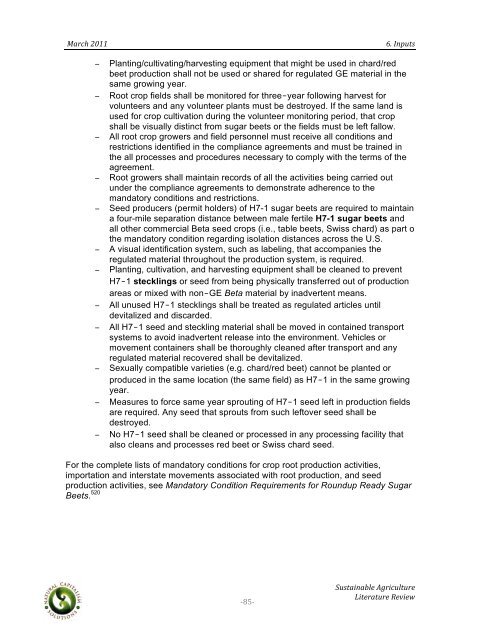Sustainable Agriculture Literature Review - Boulder County
Sustainable Agriculture Literature Review - Boulder County
Sustainable Agriculture Literature Review - Boulder County
Create successful ePaper yourself
Turn your PDF publications into a flip-book with our unique Google optimized e-Paper software.
! ! !!<br />
"#$%&!'())!! !!!!!!!!!!!!!!!!!!!!!!!!!!!!!!!!!!!!!!!!!!!!!!!!!!!!!!!!!!!!!!!!!!!!!!!!!!!!!!!!!=+!>5?324!<br />
!<br />
! Planting/cultivating/harvesting equipment that might be used in chard/red<br />
beet production shall not be used or shared for regulated GE material in the<br />
same growing year.<br />
! Root crop fields shall be monitored for three‐year following harvest for<br />
volunteers and any volunteer plants must be destroyed. If the same land is<br />
used for crop cultivation during the volunteer monitoring period, that crop<br />
shall be visually distinct from sugar beets or the fields must be left fallow.<br />
! All root crop growers and field personnel must receive all conditions and<br />
restrictions identified in the compliance agreements and must be trained in<br />
the all processes and procedures necessary to comply with the terms of the<br />
agreement.<br />
! Root growers shall maintain records of all the activities being carried out<br />
under the compliance agreements to demonstrate adherence to the<br />
mandatory conditions and restrictions.<br />
! Seed producers (permit holders) of H7-1 sugar beets are required to maintain<br />
a four-mile separation distance between male fertile H7-1 sugar beets and<br />
all other commercial Beta seed crops (i.e., table beets, Swiss chard) as part o<br />
the mandatory condition regarding isolation distances across the U.S.<br />
! A visual identification system, such as labeling, that accompanies the<br />
regulated material throughout the production system, is required.<br />
! Planting, cultivation, and harvesting equipment shall be cleaned to prevent<br />
H7‐1 stecklings or seed from being physically transferred out of production<br />
areas or mixed with non‐GE Beta material by inadvertent means.<br />
! All unused H7‐1 stecklings shall be treated as regulated articles until<br />
devitalized and discarded.<br />
! All H7‐1 seed and steckling material shall be moved in contained transport<br />
systems to avoid inadvertent release into the environment. Vehicles or<br />
movement containers shall be thoroughly cleaned after transport and any<br />
regulated material recovered shall be devitalized.<br />
! Sexually compatible varieties (e.g. chard/red beet) cannot be planted or<br />
produced in the same location (the same field) as H7‐1 in the same growing<br />
year.<br />
! Measures to force same year sprouting of H7‐1 seed left in production fields<br />
are required. Any seed that sprouts from such leftover seed shall be<br />
destroyed.<br />
! No H7‐1 seed shall be cleaned or processed in any processing facility that<br />
also cleans and processes red beet or Swiss chard seed.<br />
For the complete lists of mandatory conditions for crop root production activities,<br />
importation and interstate movements associated with root production, and seed<br />
production activities, see Mandatory Condition Requirements for Roundup Ready Sugar<br />
Beets. 520<br />
",#"<br />
!,342#.5#6/1!78$.%3/23$1!<br />
9.21$#23$1!:1;.1
















